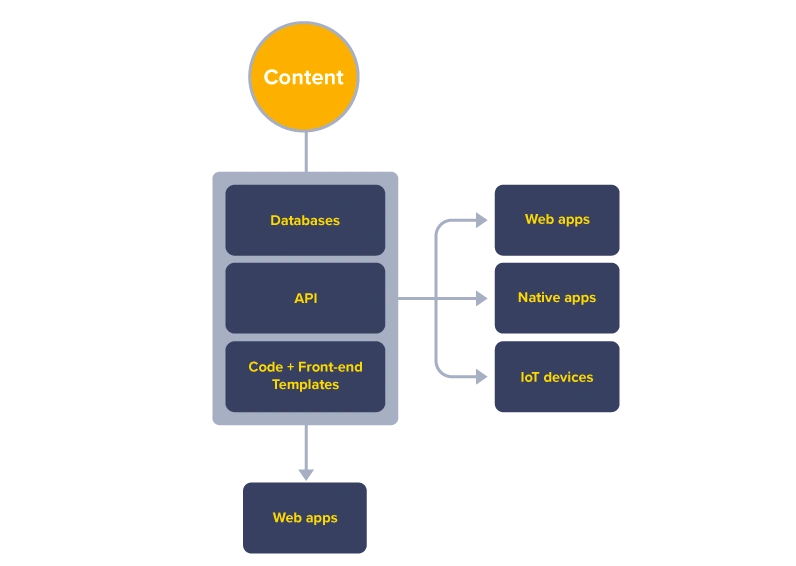
GSD
What Is a Hybrid CMS? Explained in Simple Terms
Posted by Richelle Marquito on September 18, 2024
A hybrid CMS combines elements of both traditional and headless CMSs. It features a front end like a traditional CMS but uses a content-as-a-service (CaaS) API for delivery. This means it has a presentation layer while still leveraging the flexibility of a headless architecture.
In today’s digital landscape, consumers are engaging with content across various platforms. PwC's survey finds that 86% of consumers regularly shop across at least two channels, with significant engagement on social media and online marketplaces.
A traditional CMS is not enough in this omnichannel reality. Despite that it’s user-friendly and bent toward content creators, these systems fail when it comes to a more complex website or across different channels and IoT devices.
While a headless CMS provides a cohesive omnichannel experience, it typically needs extensive developer support to set it up, which means that it is more complex and expensive at the start.
Enter hybrid CMS. It offers a promising solution to these challenges, but certain drawbacks still exist. Is it the right choice for your digital team? Let’s explore.
Table of contents
Content management hurdles in the new omnichannel norm
The rise of omnichannel marketing has amplified several content management challenges. Inconsistent customer experience, high content replication rates, and difficulty tracking user engagement across platforms have been the common hurdles.
Traditional CMSs often fall short of delivering uniform and cohesive content across different platforms. This inconsistency can lead to customer confusion and dissatisfaction, thus drastically affecting engagements and conversion.
Avoiding content replication as mentioned earlier is another major challenge. Creating content, duplicating it, and distributing it manually to different platforms has greater possibilities of redundancy errors. Content replication not only leads to inefficient workflows but also wastes time and resources.
Consistent brand messaging is also a concern for marketers. Delivering a uniform brand message across various platforms is crucial for maintaining brand integrity and trust. The fragmented nature of traditional CMSs makes it challenging to ensure that the same tone, style, and key messages are effectively conveyed across all channels.
Also, the difficulty of tracking user engagement across platforms is another concern for marketers. Each platform often has specific metrics and analytics tools, making it hard to consolidate data into an overview. Tailoring content to meet audience needs becomes nearly impossible, leading to less effective marketing strategies.
To tackle the scalability and flexibility challenges that traditional CMSs often face, headless and hybrid CMS solutions have become popular alternatives. A headless CMS separates the backend from the front end, making it easier to deliver content smoothly across various channels using APIs. On the other hand, a hybrid CMS combines the flexibility of a headless system with the user-friendly features found in traditional CMSs.
Though both of these options give brands the tools they need to scale effectively and adapt to the diverse demands of their audience, ensuring consistent content delivery across all platforms, let’s take a closer look at the latter. What exactly is a hybrid CMS? And why does it matter?
What is a hybrid CMS, and why should you care?
A hybrid CMS is a content management system that integrates the features of both traditional CMSs and headless CMSs. It allows content to be managed centrally but delivered across various platforms and devices through APIs. It combines the user-friendly interfaces of traditional CMSs with the flexible delivery mechanisms of headless CMSs and maintains a coupled front end alongside API capabilities, letting you choose the best approach for different use cases.
In a traditional CMS, the front end (user interface) and back end (content creation and management) are tightly integrated. This setup is simple to use but limits the ability to publish various content types and restricts where the content can appear. On the other hand, a headless CMS completely separates the front end from the back end, allowing content to be accessed and displayed through APIs. This separation provides greater flexibility for developers to create custom front-end experiences and offers scalability that traditional CMSs lack.
Compared to these systems, a hybrid CMS offers a middle ground where you can use a traditional-style front end or opt for API-driven content delivery. This gives it the versatility to deliver content quickly across multiple platforms while maintaining some of the user-friendly aspects of traditional CMSs. Also, it enables marketers and editors to preview their content before publication and use templates for easy content creation and formatting.
Choosing a hybrid CMS means balancing flexibility and control. It allows for flexible content delivery via APIs to various platforms, including websites, mobile apps, and IoT devices, while retaining integrated features that make it easy for non-technical users to manage content. The quick integration with popular third-party tools like CRM systems, email marketing platforms, and analytics solutions ensures efficient workflows. Furthermore, the capability to preview content before it goes live and use pre-designed templates for consistent, professional presentation enhances both the speed and quality of content production.
As for hybrid CMS architecture, it consists of an isolated backend that houses a database for various content types and a content manager for creation and upload. Authoring occurs in the backend, while one or more front-end systems handle publishing, serving as the “head” for each channel. It allows content to be dynamically published across different platforms via APIs without being tied to a single frontend. A unique feature of this architecture is its cross-channel experience that enables content to be shared seamlessly rather than isolated for each channel. Backend users are provided with tools to interact with published content, bridging "channel silos" and creating an integrated, flexible content delivery approach that enhances both management and distribution efficiency.
What are the advantages of adopting a hybrid CMS?
Let us now explore the various advantages that make hybrid CMSs a compelling choice for marketing and development teams.
Dual approach of ease and flexibility
A hybrid CMS combines the ease of content creation found in traditional CMSs with the flexibility and freedom of headless CMSs. The flexible front end and structured back end give the hybrid CMSs the best of both worlds. This approach makes it easy to create and deliver content across multiple channels without being restricted by the limitations of traditional systems. For marketing teams, this means seamless personalization and distribution of content across websites, mobile apps, and social media platforms.
Reduced learning curve
Hybrid CMS systems often feature a user interface familiar to traditional CMS users, significantly reducing the learning curve. The availability of ready-made themes, similar to those in traditional systems, greatly aids users. This is especially beneficial for content creators and marketers who need to quickly adapt to new tools without compromising productivity.
Cost efficiency in the initial setup
Hybrid CMSs can be more cost-effective initially due to the availability of built-in functionalities and pre-built templates, which reduce the need for extensive custom development. This can lower the initial investment compared to a headless CMS, which often requires substantial front-end development.
For organizations looking to quickly establish a robust content management system without significant upfront expense, a hybrid CMS offers a balanced solution that meets immediate needs and allows for gradual scaling.
Great authoring experience
Hybrid CMSs often come equipped with template management and WYSIWYG (What You See Is What You Get) authoring tools, allowing content creators to easily design and format their content. Additionally, these systems usually offer web navigation tools that can preview content before it is published. This ensures that the final output aligns with the desired look and feel, giving content creators more control and confidence in the presentation of their work.
Simplified integration process
Hybrid CMSs are designed to offer a simplified integration process by including built-in support for popular third-party software and services, such as pre-configured connectors and plugins. For example, many hybrid CMSs come with out-of-the-box integrations for widely-used CRM systems like Salesforce, email marketing platforms like Mailchimp, and analytics solutions like Google Analytics. This built-in support lets marketing teams quickly connect essential tools without extensive custom development. The result is more efficient workflows and better data utilization, enabling businesses to operate more smoothly and effectively.
What are the disadvantages of implementing a hybrid CMS?
It is important to know the potential drawbacks of hybrid CMSs to determine if they align with your organization's needs and long-term goals. Below are some key challenges to consider:
Complex customization and personalization
Customization in hybrid CMSs can be more complicated than in headless CMSs due to their dual architecture. While headless CMSs offer straightforward API-based customization, hybrid CMSs may require more intricate configurations to ensure both the front end and back end work seamlessly together.
Balancing act challenges
Hybrid CMSs strive to combine the best of traditional and headless CMSs but might face difficulties in achieving a perfect balance. Integrating robust front-end capabilities with flexible back-end structures can result in a system that’s neither as user-friendly as traditional CMSs nor as developer-centric as headless CMSs. This balancing act can lead to compromises in user experience and system efficiency, one of the things that the developer team needs to consider.
Potential for feature overlaps
With hybrid CMSs, there's a risk of redundancy in features between the front end and back end, which can lead to confusion and inefficiencies. Traditional CMSs have clearly defined roles for front-end and back-end functionalities, while headless CMSs completely decouple these aspects. For example, both the front end and back end might offer separate mechanisms for caching content. If both systems attempt to cache the same content, it could result in outdated content being displayed to users due to conflicting cache expiration policies. This inconsistency not only confuses the development process but also negatively impacts the user experience.
Long-term scalability costs
While a hybrid CMS can be an effective solution initially, scaling it to align with long-term digital strategies can be costly. As business needs evolve, the dual nature of hybrid CMSs may necessitate more frequent and extensive system adjustments compared to headless CMSs. Headless CMSs are inherently designed for scalability and flexibility. These adjustments can involve significant redevelopment efforts and resource allocation, leading to higher long-term costs for maintaining and expanding the system's capabilities.
Is it the answer for your digital teams? It depends
When considering a hybrid CMS, it’s important to weigh your specific needs and capabilities. Here are some key points to consider:
Evaluate your team's skills and resources
A hybrid CMS can offer a balanced solution, but it requires teams to be proficient in both content creation and technical management. If your team lacks either skill set, you might encounter significant challenges. On the other hand, smaller businesses or startups that already use a traditional CMS may find the transition to hybrid CMS smoother, as it offers user-friendly features combined with the flexibility of headless systems.
Consider your content strategy
If your business relies on highly personalized content distributed across various channels, a hybrid CMS might be a good fit. However, if your strategy leans more toward standard web content without significant multi-channel distribution, a traditional CMS may be sufficient. Conversely, if your focus is on API-driven architectures with maximum flexibility and minimal front-end constraints, a headless CMS might be more appropriate.
Think about long-term goals
Consider your organization's long-term digital strategy. A hybrid CMS can provide a robust solution for current needs but think about whether it will scale with your future objectives. Assess how easily you can integrate new technologies and adapt to changing market demands with a hybrid system. While hybrid CMSs can be more cost-effective initially due to their built-in functionalities and pre-built templates, the complexity of managing both front-end and back-end components can lead to higher ongoing maintenance and customization costs.
In contrast, headless CMSs, though potentially requiring a higher initial investment for custom development and setup, are designed with future scalability in mind. They offer unmatched flexibility for integrating emerging technologies and supporting complex, omnichannel experiences.
This makes headless CMSs potentially more adaptable to evolving business requirements in the long run, as they can be more cost-effective to scale and maintain. By decoupling the front end from the back end, headless CMSs reduce the need for frequent, extensive system adjustments, thereby lowering long-term operational costs.
Look at industry trends and stats
According to Adobe, businesses were able to create and deliver digital experiences much faster with hybrid CMS. Here are the figures:
-
It took 56% less time to put up a launch page.
-
It was 64% faster to complete a minor editorial change.
-
Web admin teams delivered 78% more content.
-
Web editorial/marketing teams achieved 32% higher productivity.
These data points highlight the superior efficiency of hybrid CMSs in content creation and management. They show that businesses can launch pages faster, make quicker editorial changes, produce more content, and achieve greater productivity, underscoring the effectiveness of hybrid CMSs in streamlining digital content workflows.
When to consider other options
You might opt for a headless CMS like ButterCMS if your primary requirement is API-first flexibility and you have a strong development team to support it. This approach is especially beneficial for large-scale enterprises that prioritize custom front-end experiences across various platforms. On the other hand, if ease of use and a more straightforward system are crucial for your small team or individual projects, a traditional CMS might be the most practical choice.
Ready to make an informed decision? For a deeper dive into choosing the right CMS for your organization, check out our detailed blog post: How to Choose a CMS.
Hybrid CMS FAQs
What is the difference between decoupled and hybrid CMS?
While often used interchangeably, there are distinct differences between a decoupled CMS and a hybrid CMS. A decoupled CMS refers to a system where the back end (content creation and storage) is completely separate from the front end (content presentation). This separation allows you to manage and update the back end without affecting the front end and vice versa, providing a clear division of labor between content management and content delivery.
In contrast, a hybrid CMS incorporates features of both traditional coupled systems and headless systems. Unlike a purely decoupled CMS, which strictly separates the content management and presentation layers, a hybrid CMS offers the ability to use traditional web interfaces and templates while also providing API-driven content delivery for more varied platforms. This dual approach gives you flexibility in how you present and manage content, allowing you to leverage the strengths of both coupled and headless architectures in one system.
For example, in a decoupled CMS, if you update the content schema in the back end, you don’t need to worry about immediately reflecting those changes in the front end, which might be managed by a completely different system.
However, in a hybrid CMS, you can still use the traditional front-end templates familiar to your marketing team for web content while also using APIs to push that same content to a mobile app or IoT device. This combination allows hybrid CMSs to provide more flexibility and adaptability, accommodating various content delivery needs without creating unnecessary complexity.
What are common use cases for a hybrid CMS?
-
E-commerce platforms: Manage a vast catalog of product content while delivering personalized experiences across multiple channels. It is suited for hybrid CMS due to the need for seamless integration with various marketing tools and platforms.
-
Media and publishing: Streamline content creation and distribution across websites, mobile apps, and social media channels. Hybrid CMS facilitates handling high-volume content and distributing it efficiently.
-
Corporate websites: Manage multiple regions and languages from a single platform. A hybrid CMS is ideal because of its scalability and adaptation to diverse market needs.
What are the best hybrid CMSs on the market in 2024?
-
Agility CMS: Agility CMS features a composable architecture with independent, reusable components that can be easily mixed and matched. It offers faster development, reduced maintenance time, and enhanced security through decoupling from the front end.
-
Brightspot CMS: Brightspot CMS offers extensive customization and integration capabilities. It is good for enterprises needing a versatile solution for complex content management.
-
Zesty.io: Zesty.io combines the flexibility of a headless CMS with the streamlined user experience of traditional content management. Perfect for businesses needing a powerful, user-friendly platform for diverse content needs.
Final thoughts
Hybrid CMS is a powerful tool that bridges the gap between traditional and headless CMSs, offering a balanced mix of flexibility, usability, and efficiency. While it has its complexities and costs, its capabilities can significantly enhance your content management strategy. Before making a decision, carefully weigh the pros and cons to determine if a hybrid CMS is the right fit for your organization.
For more insights on choosing the right CMS, don't forget to check out our comprehensive guide: How to Choose a CMS.
ButterCMS is the #1 rated Headless CMS
Related articles
Don’t miss a single post
Get our latest articles, stay updated!

















Richelle Marquito is a Product Manager with more than 10+ years of experience in the software industry. She is passionate about software technologies and has various knowledge in software development processes, continuously applying this expertise to streamline project workflows and enhance team productivity.